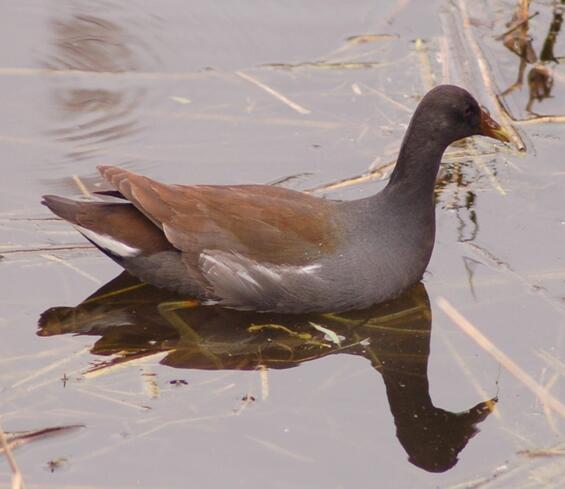- Scientific name: Gallinula galeata
- Species of Greatest Conservation Need (MA State Wildlife Action Plan)
- Special Concern (MA Endangered Species Act)
Description

Common gallinule
The common gallinule, formerly known as the common moorhen, is a duck-like swimming bird about 33 cm (13 in) long, with a 53 cm (21-in) wingspan and large, yellow feet that are not webbed. Adults have a black head and neck with a yellow-tipped red bill that extends into a red shield on the forehead. These red areas become brownish in winter. The back is brownish and the under-parts are slate-colored. The tail is short and upturned with white outer undertail coverts and black inner ones. Juveniles are paler and browner with a whitish throat. Both juveniles and adults have white streaking on the flanks that appears as a thin white line when the wings are down. Fledglings are black and downy with the yellow-tipped red bill but lacking the frontal shield. Calls include series of whiny clucks as well as short, squawking screams.
Life cycle and behavior
The common gallinule generally keeps to the cover of dense vegetation, wading or dabbling at the edges of open water to feed on grass and sedge seeds, berries, foliage, underwater plants, and duckweed, along with invertebrates such as insects, snails, and worms. It arrives in Massachusetts from the south in late April or May, beginning to nest in May or early June. Nests - well concealed by a canopy of surrounding plants - are typically built over water, usually less than one foot high. The nest is usually anchored in a clump of vegetation or occasionally built in a shrub and consists of a bulky but well-made cup of dead cattails, rushes, and stems of other aquatic plants. Typical nest dimensions are 38 cm (15 in) across and 20 cm (8 in) tall, with an inside diameter of 20 cm (8 in) and depth of 7.6 cm (3 in). There is often a ramp leading from the water to the nest. Incomplete nest-like platforms, used for roosting or brooding, may be found nearby. Beginning in late May, the female lays 6-17 (usually around 10-12) brownish, spotted eggs, which are incubated by both parents for 3 weeks. The male cares for the first-hatched chicks while the female incubates the remaining eggs, the last of which hatch by mid-July. The young are precocial, leaving the nest within a day of hatching. They can feed independently after 3 weeks, and can fly in 6-7 weeks, but remain with their parents for a while after this. There may be one or two broods per year. Common gallinules return to their wintering range in October.
Population status
The common gallinule is considered globally secure but is a rare breeder in Massachusetts and is listed as a special concern. Most breeding sites in Massachusetts support only single breeding pairs.
Distribution and abundance
The common gallinule and its close relative, the common moorhen, are found almost worldwide, but are absent from polar regions and Australia. In North America, the gallinule’s breeding range covers most of the eastern United States and extends into southern Ontario; birds in this region winter from South Carolina and the Gulf Coast south, or occasionally as far north as New England. Common gallinules can also be found throughout the year in parts of California, Arizona, and New Mexico, and across much of Mexico. In Massachusetts, they have been found breeding locally across the state, except there are no records from Martha’s Vineyard.

Distribution in Massachusetts. 1999-2024. Based on records in the Natural Heritage Database.
Habitat
This species inhabits large, freshwater or brackish marshes. Suitable water bodies are at least a foot deep and have dense cattail beds, and occasionally shrub marsh, adjacent to open water with aquatic bed vegetation.
Healthy habitats are vital for supporting native wildlife and plants. Explore habitats and learn about conservation and restoration in Massachusetts.
Threats
The loss of substantial amounts of suitable freshwater marsh habitat through drainage and development is likely responsible for the initial population decline in Massachusetts. Crowley’s study documented an inverse relationship between the density of houses within 100 m (109 yd) of wetlands and the likelihood of various marsh bird species occurring there. In addition, MassWildlife’s Natural Heritage Endangered Species Program’s (NHESP) field surveys find the largest limiting factor to currently occupied sites to be the presence of invasive plants, particularly Phragmites.

Conservation
Given that habitat loss is the greatest threat to the common gallinule, preserving and restoring suitable freshwater marshes is critical to its persistence in Massachusetts. The maintenance of current habitat by control of invasive species would address the primary threat to occupied sites. Protection of a 100 m (109 yd) upland buffer around known breeding sites is recommended to reduce adverse effects of disturbance from human activities. Regular inventory for new sites and monitoring of known sites are important for understanding the dynamics of the common gallinule populations and planning management where appropriate. Climate change is likely adversely impacting this species by changing hydrologic regimes that sustain wetland and marsh habitats.
References
Bannor, B.K., and E. Kiviat. 2002. Common Moorhen (Gallinula chloropus), The Birds of North America Online (A. Poole, Ed.). Ithaca: Cornell Lab of Ornithology; Retrieved from the Birds of North America Online: http://bna.birds.cornell.edu/bna/species/685
Crowley, S.K. 1994. Habitat use and population monitoring of secretive waterbirds in Massachusetts. M.S. Thesis, University of Massachusetts, Amherst.
Contact
| Date published: | April 4, 2025 |
|---|